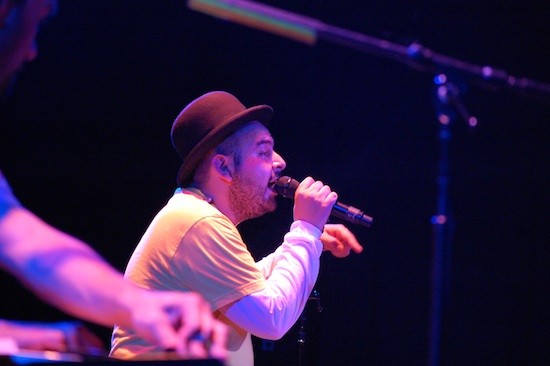
Mexican Institute of Sound
January 21, 2012
Segerstrom Institute of Sound
So the movie The Artist is currently the talk of the town because of its pseudo-retro-avant garde approach of engaging viewers with silence, as they manage to develop the story without the need of sound. (That, and the fact that it costars a kick-ass Jack Russell terrier). After all, when it comes to telling a story, sound is overrated, right? Wrong. Don't ever underestimate the power of sound to tell a story–and when it comes to pseudo-retro avant garde sound, Mexican Institute of Sound (M.I.S.) has quite the story to tell.
M.I.S.officially hit the music scene in 2006 when D.J./producer Camilo Lara, who had previously (and preciously) produced tracks independently as Christmas gifts for family and friends, released Méjico Máxico. He followed it up with Piñata in 2007, and most recently, 2010's Soy Sauce. Although it sounds like the name of a band, really, it's a one-man show, live appearances supplemented with a guitarist and a drummer. Its sound is fusion at its greatest, infusing funk with cumbia, hip-hop with mambo, electronica with banda and norteño, all in a way that is so natural, it's really not a fusion but rather a creation of its own merit–mextrónica, as it has been coined.
]

It was surprising to hear that such an innovative musical act as M.I.S. would be performing in Orange County given the tragic decline of our local Latino alternative music scene. Gone
are the days when immortal and up-and-coming artists alike performed in an intimate setting, such as the legendary–but now extinct–venue J.C. Fandango.
The concert was not well attended, and quite frankly, that was disappointing to see. However, the audience's enthusiasm made up for the lack of numbers, and I was surprised to see near equal parts of white middle-aged concert goers to the Latino crowd. (Kudos to the Anglo adventurers!)
From the moment M.I.S. got on stage, the crowd was energetic and the Institute delivered. They started the show with “Cumbia,” full of horns, synthesizers, bass beats, and spoken word. Although a very current dance track, it was also very retro, incorporating static mambo beats one would expect to hear from their grandparent's vinyl. Three songs into the set, the creative mastery was evident as they performed “Alocatel,” a classic rock-n-rollesque tune fused with dripping sounds, and noises like those that pinball machines make when you pull the plunger. But beyond the catchiness of the song, the genius was in M.I.S.'s ability to mix in Tony Basil's all-American “Mickey” and then seamlessly transition to Los Del Rio's hypnotic “Macarena,” managing to simultaneously bring us back to junior high and a cousin's 1996 wedding.
Speaking of cousin's weddings, the next tune, “Yo Digo Baila,” meshes banda sinaloense trumpets with synth beats that rival any LMFAO track. Through it, not only is the musical gap many young Latinos experience with their ancestral ethno-musical history bridged, but language barriers are quickly torn down by nonchalantly translating, “Yo digo baila, tu dices dance” (I say dance, you say baila).
Well into show, M.I.S.'s sense of humor was well evident as they explored topics such as, um, body hair in “Belludita,” a tune full of both deep bass reminiscent of JJ Fad's “Supersonic” mixed with Columbian cumbias. In “Mirando Muchachas” they ironically used '70s go-go dancing beats with Roberto Carlos' “Amigo” (which he wrote as the anthem for Pope John Paul II to describe the recreational activity of girl watching). God forgive me, but how can one not visualize the Pope in the Popemobile, leading a parade full of go-go dancers, white platform boots and all?
Although most of the songs were feel-good, fun songs, as show crossed over to the second half, M.I.S. advantageously capitalized on the captive audience and sang matters of social significance, such as in “El Micrófo,” a song with an industrial beat that talked about the microphone as a trendy weapon, one to be used with caution and one that is used superficially by some so-called artists.
As the show wrapped up, the fun was once again summoned. As electronica (or rather, mextrónica) beats blasted, the most good-looking women in the crowd were invited on stage, and just as the party was in full force once again, Camilo lowered his synthesizer stand, and quietly pushed it off stage.
The music suddenly stopped, and the band exited the stage. Without a further sound, the concert was over, and the awkward silence was a reminder of the power of sound. It was silence that ended the show, but it was sound that engaged us, took us on the journey and told us the story of the meshing of genres, languages, and the soundtracks of past generations, the soundtracks of our generation.
Critic's Bias: I have a Sex Pistol tattoo on my arm.
The Crowd: Many white middle-aged concert goers (who were quite into it).
Overheard in the Crowd: There wasn't really any talking, just dancing and jumping.
Random notebook dump: The bravest soul was a 60something, grey-haired man in a floral shirt who started a soul train line, but unfortunately, nobody other than his much younger date followed suit.
Setlist:
Cumbia
La Kebradita
Alocatel
Yo Digo Baila
Bienvenidos a Mi Disco
Belludita
Mirando las Muchachas
Jaja Pipi/Hip Hop Don't Stop
Escribeme Pronto
El Micrófono
(unclear)
(unclear)
Encore:
None. Segerstrom security were having none of it so the roadies immediately got to work but Camilo casually roamed back in and people approached for photos.

